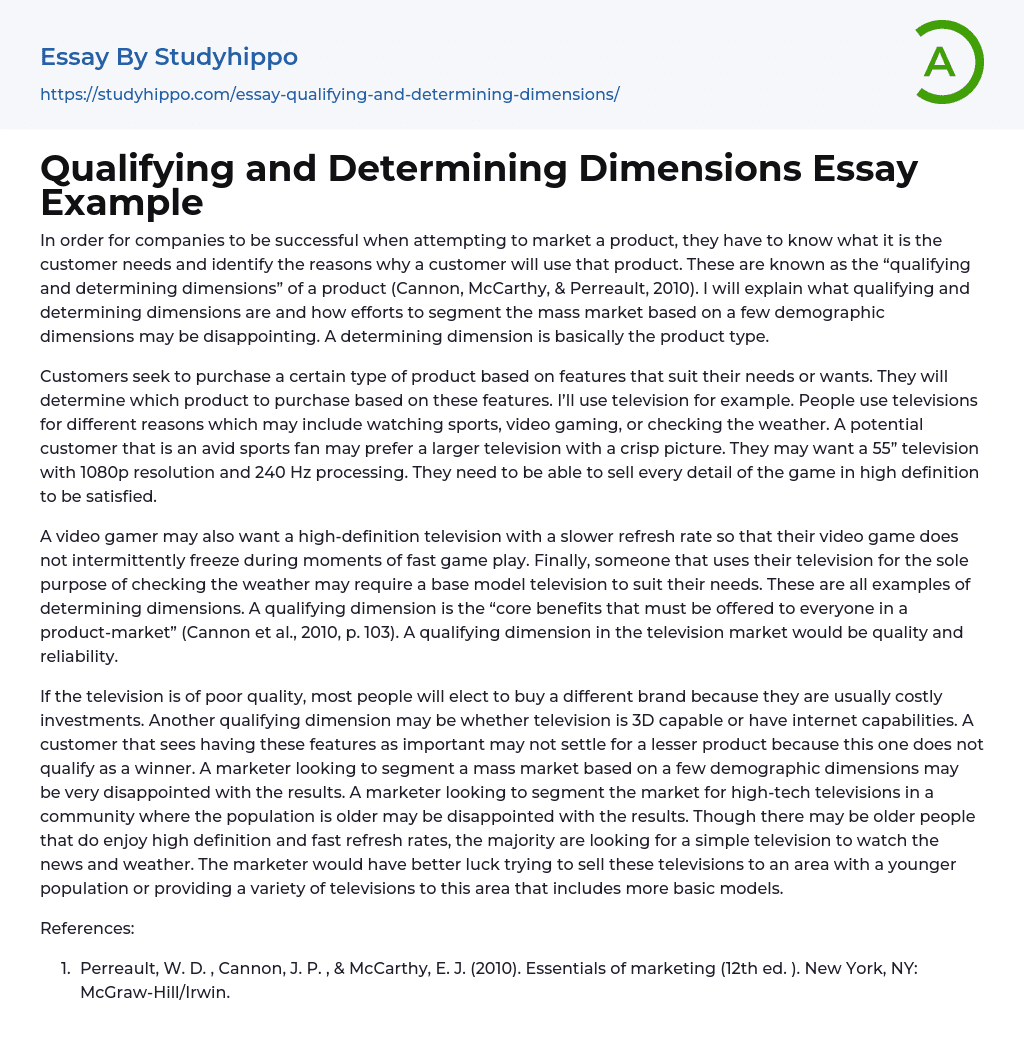In order for companies to be successful when attempting to market a product, they have to know what it is the customer needs and identify the reasons why a customer will use that product. These are known as the “qualifying and determining dimensions” of a product (Cannon, McCarthy, & Perreault, 2010). I will explain what qualifying and determining dimensions are and how efforts to segment the mass market based on a few demographic dimensions may be disappointing. A determining dimension is basically the product type.
Customers seek to purchase a certain type of product based on features that suit their needs or wants. They will determine which product to purchase based on these features. I’ll use television for example. People use televisions for different reasons which may include watching sports, video gaming, or checking th
...e weather. A potential customer that is an avid sports fan may prefer a larger television with a crisp picture. They may want a 55” television with 1080p resolution and 240 Hz processing. They need to be able to sell every detail of the game in high definition to be satisfied.
A video gamer may also want a high-definition television with a slower refresh rate so that their video game does not intermittently freeze during moments of fast game play. Finally, someone that uses their television for the sole purpose of checking the weather may require a base model television to suit their needs. These are all examples of determining dimensions. A qualifying dimension is the “core benefits that must be offered to everyone in a product-market” (Cannon et al., 2010, p. 103). A qualifying dimension in the television market would be quality
and reliability.
If the television is of poor quality, most people will elect to buy a different brand because they are usually costly investments. Another qualifying dimension may be whether television is 3D capable or have internet capabilities. A customer that sees having these features as important may not settle for a lesser product because this one does not qualify as a winner. A marketer looking to segment a mass market based on a few demographic dimensions may be very disappointed with the results. A marketer looking to segment the market for high-tech televisions in a community where the population is older may be disappointed with the results. Though there may be older people that do enjoy high definition and fast refresh rates, the majority are looking for a simple television to watch the news and weather. The marketer would have better luck trying to sell these televisions to an area with a younger population or providing a variety of televisions to this area that includes more basic models.
References:
- Perreault, W. D. , Cannon, J. P. , & McCarthy, E. J. (2010). Essentials of marketing (12th ed. ). New York, NY: McGraw-Hill/Irwin.
- Chief Executive Officer essays
- Convenience Store essays
- Firm essays
- Training And Development essays
- Unilever essays
- Variable Cost essays
- Virgin Group essays
- Bargaining essays
- Entity essays
- Pest analysis essays
- Advertising essays
- Audience Theory essays
- Competitor Analysis essays
- Consumer essays
- Marketing Management essays
- Marketing Mix essays
- Marketing Plan essays
- Marketing Research essays
- Marketing Strategy essays
- Point Of Sale essays
- Price essays
- Procurement essays
- Product essays
- Product Differentiation essays
- Promotion essays
- Promotion And Marketing Communications essays
- Retailing essays
- Trademark essays
- Anheuser-busch essays
- Brands essays
- Detergent essays
- Product Placement essays
- Research Design essays
- New Product Development essays
- Advertisement essays
- Brand essays
- Sales Promotion essays
- Advertising campaign essays
- Consumer behaviour essays
- Offer And Acceptance essays
- Wal-Mart essays
- Discover essays
- John Locke essays
- 9/11 essays
- A Good Teacher essays
- A Healthy Diet essays
- A Modest Proposal essays
- A&P essays
- Academic Achievement essays
- Achievement essays




